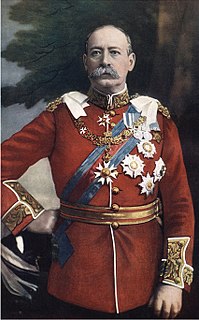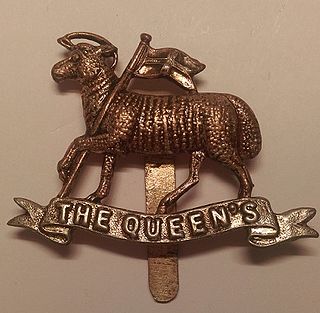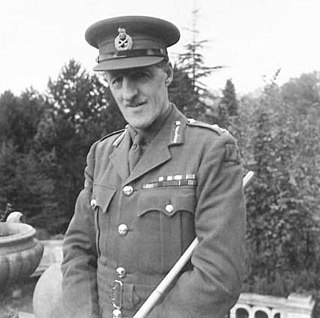Related Research Articles

Charles Henry Gordon-Lennox, 7th Duke of Richmond and Lennox, 2nd Duke of Gordon,, 7th Duke of Aubigny, styled Lord Settrington until 1860 and Earl of March between 1860 and 1903, was a British politician and peer.

Field Marshal Francis Wallace Grenfell, 1st Baron Grenfell, was a British Army officer. After serving as aide-de-camp to the Commander-in-Chief, South Africa, he fought in the 9th Xhosa War, the Anglo-Zulu War and then the Anglo-Egyptian War. He went on to become Sirdar (Commander-in-Chief) of the Egyptian Army and commanded the forces at the Battle of Suakin in December 1888 and at the Battle of Toski in August 1889 during the Mahdist War. After that he became Governor of Malta and then Commander-in-Chief, Ireland before retiring in 1908.

The Welch Regiment was an infantry regiment of the line of the British Army in existence from 1881 until 1969. The regiment was created in 1881 under the Childers Reforms by the amalgamation of the 41st (Welch) Regiment of Foot and 69th Regiment of Foot to form the Welsh Regiment, by which it was known until 1920 when it was renamed the Welch Regiment. In 1969 the regiment was amalgamated with the South Wales Borderers to form the Royal Regiment of Wales.

Lieutenant-General Sir William Forbes Gatacre was a British soldier who served between 1862 and 1904 in India and Africa. He commanded the British Army Division at the Battle of Omdurman and the 3rd Division during the first months of the Second Boer War, during which time he suffered a humiliating defeat at the Battle of Stormberg.

The Queen's Royal Regiment was a line infantry regiment of the English and later the British Army from 1661 to 1959. It was the senior English line infantry regiment of the British Army, behind only the Royal Scots in the British Army line infantry order of precedence.

The Royal Lincolnshire Regiment was a line infantry regiment of the British Army raised on 20 June 1685 as the Earl of Bath's Regiment for its first Colonel, John Granville, 1st Earl of Bath. In 1751, it was numbered like most other Army regiments and named the 10th Regiment of Foot. After the Childers Reforms of 1881, it became the Lincolnshire Regiment after the county where it had been recruiting since 1781.

The Leicestershire Regiment was a line infantry regiment of the British Army, with a history going back to 1688. The regiment saw service for three centuries, in numerous wars and conflicts such as both World War I and World War II, before being amalgamated, in September 1964, with the 1st East Anglian Regiment, the 2nd East Anglian Regiment and the 3rd East Anglian Regiment to form the present day Royal Anglian Regiment, of which B Company of the 2nd Battalion continues the lineage of the Royal Leicestershire Regiment.

General Sir William Platt was a senior officer of the British Army during both World War I and World War II.
Ramsay Weston Phipps was an Irish-born military historian and officer in Queen Victoria's Royal Artillery. The son of Pownoll Phipps, an officer of the British East India Company's army, he was descended from the early settlers of the West Indies; many generations had served in the British, and the English military. Phipps served in the Crimean War, had a stint of duty at Malta, and helped to repress the Fenian uprising in Canada in 1866.

Admiral Sir Vernon Harry Stuart Haggard, KCB, CMG was a Royal Navy officer who went on to be Commander-in-Chief, America and West Indies Station. His career in the Royal Navy spanned forty-four years, from his entry as a youth in 1888 to his promotion to admiral in 1932.
Major General Sir Reginald Laurence Scoones, was a British Army officer who served during the Second World War and its aftermath. His older brother was General Sir Geoffry Scoones.
Sir William Henry Elliott, was a British Army general.
Brigadier General Henry Huntly Leith Malcolm was a Scottish officer in the British Army during the Anglo-Egyptian War and World War I.

Rev. William Champion Streatfeild MA (1839–1912) was an English clergyman and descendant of the historic Streatfeild family. In his retirement he lived at Chart’s Edge and Hoseyrigge, in Westerham Kent.

Major-General Robert Knox Ross was a senior British Army officer who, during World War II, commanded the 53rd (Welsh) Infantry Division throughout the campaign in North-West Europe from June 1944 until May 1945.
General Sir John Doran was a British Army officer from an established Irish family with links to Irish nobility. He saw extensive service in India and the North West Frontier. He had originally taken a commission in one of the East India Company Regiments in 1842.

Brigadier John Sebastian Nichols, was a British Army officer who fought during both the First World War and the Second World War. During the latter his most notable role was when he commanded the 50th (Northumbrian) Infantry Division during the Second Battle of El Alamein and in the Tunisian Campaign from 1942 to 1943.
Brigadier General Walter Robert Butler Doran, was a highly decorated and senior British Army officer who served with distinction in the Second Boer War commanding an infantry battalion, and was a brigade commander during the First World War.
Major General William Robb was a senior British Army officer, who served in both World War I and World War II.
Brigadier John Alan Lyde Caunter was a senior British Army officer and a pioneer shark angler off the British coast. He published an account of his escape from Germany as a prisoner of war in World War I.
References
- ↑ Ireland Births and Baptisms, 1620–1911 , retrieved 16 November 2016
- ↑ London Gazette (PDF), retrieved 16 November 2016
- ↑ London Gazette (PDF), retrieved 16 November 2016
- ↑ Bourne, John, Centre for First World War Studies , retrieved 16 November 2016
- ↑ Anglican Parish Registers, Chiddingfold, St Mary, Surrey History Centre, Woking, Surrey
- ↑ England and Wales Death Registration Index 1837-2007 , retrieved 16 November 2016
- ↑ England and Wales Marriage Registration Index , retrieved 16 November 2016
- ↑ Calendar of the Grants of Probate and Letters of Administration made in the Probate Registries of the High Court of Justice in England, Principal Probate Registry, London